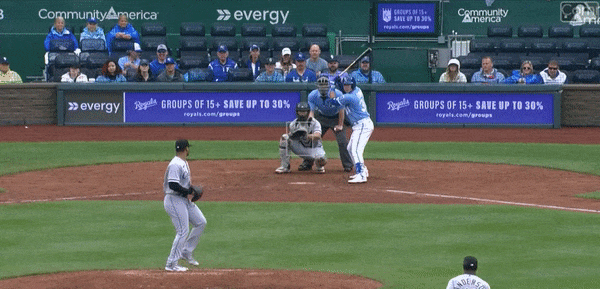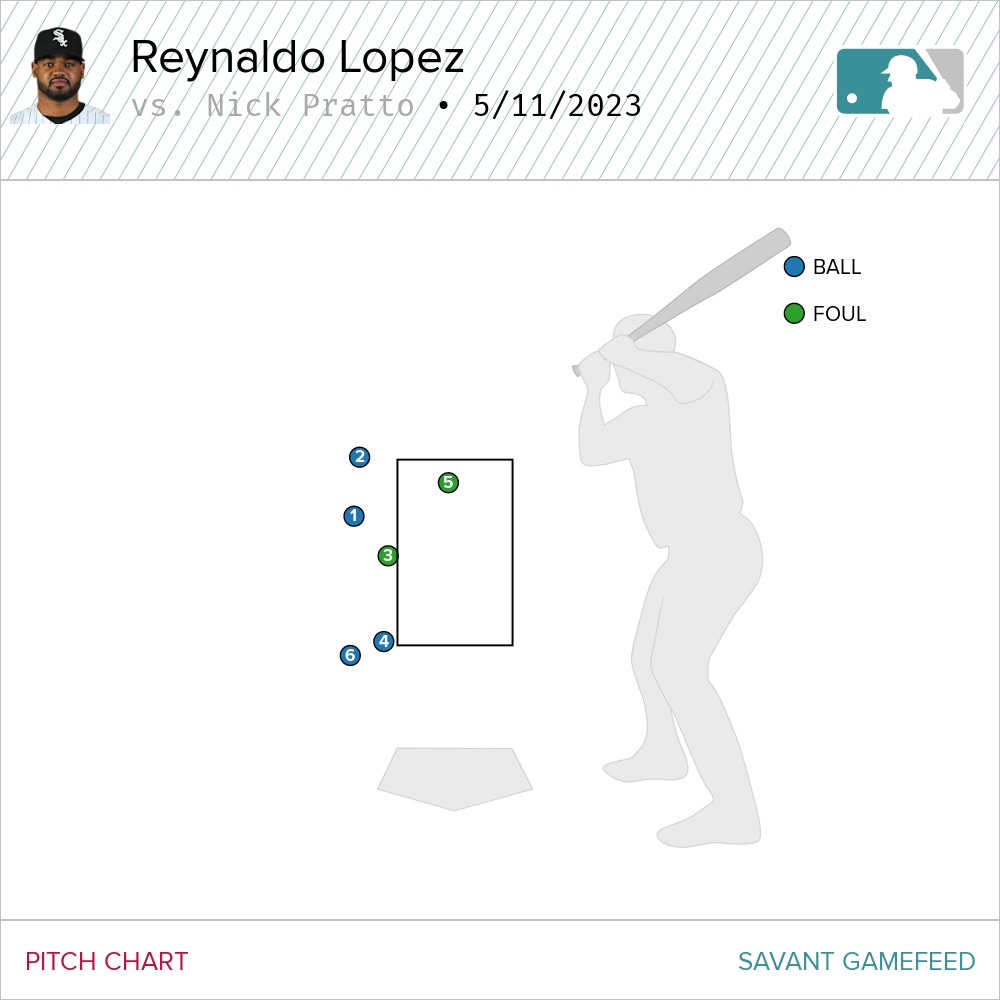Squeezing out a victory
A bunt gives the Royals a series win against the White Sox and caps a successful homestand for the offense.
That was a different way to win a ballgame.
The Royals have been on a bit of a home run tear of late. They just finished a homestand where they launched at least one bomb in each of the 10 games. Michael Massey had the honors on Thursday, the second game in a row where he left the yard. (By the way, Massey has 10 hits in his last 21 at-bats and has hit in seven consecutive games.) It’s a plot twist I don’t think anyone saw coming.
But when they needed one run in the ninth to get the victory, Freddy Fermin didn’t swing for the fences. Nope. He dropped down a beauty of a bunt.
Ballgame. Yes, a walk-off bunt for a 4-3 victory over the Chicago White Sox. The Royals are winners of four of their last five and finished this homestand with an even 5-5 record. April? Pfffft. That was long ago.
As for Fermin and his game-winning bunt, that’s just an incredibly difficult pitch to get down. A fastball at 98 MPH bearing in on your hands? Thanks, I’ll pass. Credit to Fermin for hanging in there and dropping down a beauty. It couldn’t have been more perfect.
Statcast isn’t just for the bombs, you know. Fermin’s bunt had an exit velocity of 51 MPH and a launch angle of -61 degrees. It first made contact with the dirt three feet in front of the plate.
Score runs however you can, whenever you can.
If I called the bunt before it happened, but I was alone, do I make a sound? The possibility of a bunt in that situation didn’t enter my mind until the Bally’s KC production team had a great closeup of Fermin as he stepped into the box. It caught a moment where his eyes briefly darted around. My first thought was that he was feeling the situation at hand. Nerves probably. Then I thought…he’s checking the positioning of the infield because he’s going to bunt.
At that moment, it made plenty of sense to me. The White Sox infield was playing halfway, giving them the opportunity to ideally turn two, or, if the situation called for it, to make a throw to the plate. A good bunt would remove both options. All Fermin would need to do would be to get it down. Hardly a simple task against a pitcher slinging triple-digit heat.
While I have made no bones about my distaste for the bunt, please understand that I am fervently against the sacrifice bunt. A squeeze to win the game? Oh yeah. Gimme.
How about some walk-off bunt ephemera? Dating back to 1969, there have been a total of 53 walk-off bunts. Several have been of the squeeze variety. Others have been sacrifice attempts where an error was made allowing a runner to score.
Fermin’s bunt was the fourth time in Royals franchise history they walked off with a bunt. The first two were courtesy of Frank White. In fact, he’s the only player since 1969 with multiple walk-off bunts. His first one came in 1975 against the New York Yankees in the bottom of the 11th inning. The second was in 1982 against the Milwaukee Brewers and came against Rollie Fingers. As far as I can tell, Fingers is the only Hall of Famer to give up a walk-off bunt going back to 1969. That was a wild game, scoreless through eight but finished 5-4. Both of White’s were of the squeeze variety where there was a runner on third.
The other walk-off bunt for the Royals was a sacrifice attempt from Gary Gaetti against the Toronto Blue Jays in 1993. A throwing error allowed the winning run to score from second. Fun bit of trivia: George Brett reached base in each of the innings where the Royals pulled off the walkoff bunt. He was like their walk-off bunt Zelig. At least until Thursday afternoon.
Courtesy of the fantastic Stathead resource at Baseball-Reference, this is the list of all the walkoff bunts since 1969. I don’t know about you, but I can lose myself in this sort of stuff.
The bunt doesn’t happen if Fermin’s teammates don’t come through in front of him. This was Nick Pratto’s plate appearance against reliever Reynaldo Lopez in the ninth.
All six pitches were fastballs. The first one was at 97.3 MPH and the five that followed got increasingly quicker. The last pitch registered at 100.1 MPH.
It’s just a nice plate appearance. Pratto watched the first two pitches well outside to get ahead 2-0. He let it fly on the third pitch, which was just off the plate, and fouled it off. After watching another fastball to reach a favorable 3-1 count, Lopez uncorked a high strike that Pratto again fouled off.
That’s a disciplined plate appearance. Against left-handed hitters, Lopez prefers to let it eat with the heater. He spins a slider only 22 percent of the time. I would imagine Pratto was sitting dead red, especially as Lopez fell behind in the count.
Lopez will throw those sliders against the right-handed hitters, which is what he offered to Matt Duffy on the first pitch of his at-bat. I’ve just been so impressed with Duffy since the start of the season. The guy seems to slow the game down just enough to stay within himself which leads to good plate appearances and solid defense when he’s in the field. (Sorry for the cliches, but it feels like the truth.) The first slider was well off the plate that Duffy jumped at, checking his swing but going too far. The second pitch was a fastball right down the chute that he looked at for the second strike.
Down 0-2 this was the opposite of Pratto’s plate appearance. Duffy dug himself a hole, but he had seen both of Lopez’s offerings. Maybe that helped because he was able to hold off on another slider that dropped out of the zone for a ball. Duffy then fouled off a 100 MPH heater on the inside corner. Lopez went back to pretty much the same location with the same pitch, just caught a bit more of the plate.
This time, Duffy kept his hands in and angled it to right field. It was a great swing to basically fight off a strike and it allowed Pratto to scoot around to third. A fine piece of hitting that set up the victory.
Here’s manager Matt Quatraro on the safety squeeze:
“To get that bunt down against (Lopez) is really, really impressive. As soon as it was first and third, thinking through where we are in the order, how difficult it is to get a ball off the ground against Lopez and how hard he throws…I mean he’s really tough. So, trying to put Freddy in the best spot there and obviously give us the best chance to win.”
I thought it was interesting Quatraro would mention getting the ball off the ground, thinking about a sacrifice fly in that situation. Lopez has a 32 percent flyball rate this year, which is a bit above his career rate of 26 percent. I don’t think it’s necessarily difficult to get the ball off the ground against Lopez (his ground ball rate this year is 39.5 percent, 36 percent for his career), but I can understand the process behind the call.
I also love the fact that Quatraro is thinking about putting his players in positions where they can succeed. I’m not sure that’s always been a consideration in the Royals dugout in the past. Good things should come from that thought process.
At the start of the ninth inning, the game was basically a coin flip.
The difference between a 4-6 record and a 5-5 record feels enormous, given how badly the team played in April and how high-octane the offense has been in this stretch. The Royals were looking good value early thanks to a solid Brady Singer start, a timely hit from Maikel Garcia and an aggressive send home from Vance Wilson to score Nick Pratto on that hit from Garcia.
The Sox turned the tables against Aroldis Chapman in the eighth with a two-out rally consisting of back-to-back singles ahead of a Luis Robert Jr. double to tie the game. It’s the third time in his last six appearances that Chapman has allowed two runs to score. After eight consecutive scoreless innings to open the year, he’s now allowed seven runs (six earned) in his last 5.2 frames. Not great.
But the heroics of Pratto, Duffy and Fermin (along with Scott Barlow who pitched a clean ninth) assured the Royals would take three of four from the spiraling White Sox and break even on this homestand.











That's some very fine managing, partly because it worked and partly because of the reasoning. Great execution by Fermin too.
I'm a little doubtful about this, but maybe Eaton needs more time at Omaha. He only had 27 PA's there last time. And even though his OPS was over .900 clearly something didn't get fixed.
Usually I'm the guy who says "leave him in the lineup every single day. You don't get better at hitting MLB pitching by not hitting MLB pitching." The gap between AAA and MLB has never been wider and he's an excellent example of that.
I'll admit that the guy is a complete mystery to me. It may turn out that he's just the quintessential AAAA player but I hope not.